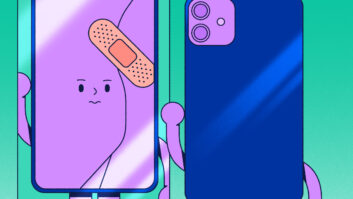NEW YORK —
Smartphone connectivity with aftermarket
car audio systems will widen and deepen at
next month’s ICES, where select suppliers will expand
and improve connectivity to Android phones in a reflection
of Android’s growing market share.
Dealers will also find an expanded selection of OEM
navigation systems designed as factory-fit, factory-look
replacements for OEM navigation systems, and more
of the systems will be targeted to aftermarket dealers,
not just to expediters.
Also at the show, Kenwood will unveil its first five
head units incorporating software that simplifies and
reduces the cost of integrating with a Ford Sync OEM
infotainment system. The five head units will connect to
a third-party integration module that bridges Kenwood
heads with Ford Sync systems.
In expanding and improving connectivity to iPhones
and iPod Touches:
* At least two more suppliers will make it possible
to display maps from a navigation app running on an
iPhone, joining JVC and Pioneer in offering this feature.
At least one of the newcomers will enable control of
the nav app from the head unit, as Pioneer’s AppRadio
head unit does.
* Head-unit control of Pandora Internet radio on a
USB-connected iPhone will expand to more head units,
with at least three suppliers expanding their selection,
and at least one adding the feature for the first time.
• At least one supplier will adopt what it called an advanced
external mode to control most functions of select
compatible apps running on a USB-connected iPhone,
including navigation and traffic apps as well as select Internet
radio apps. Pioneer’s AppRadio already controls select
iPhone apps, including traffic and navigation.
• At least one supplier will adopt Mirror Link technology,
the industry-standardized technology that enables compatible
aftermarket and OEM
head units to display the user
interface, apps, and content of
Mirror Link-compatible smartphones,
the first of which is expected
to become available in
2012 in the U.S. Mirror Link will
be available on select Android
and Symbian phones.
With MirrorLink, consumers
will use their head unit’s touchscreen
to control smartphone
apps and functions in the same way that they would use
the smartphone’s touchscreen to control apps and functions.
• At least one supplier could become the first aftermarket
supplier in the U.S. to adopt iPod Out mode, which
enables multimedia head units’ larger screens to display a
user interface transferred from a connected iPod/iPhone.
The feature has also begun to appear in OEM head units.
With iPod Out, head-unit control of iPods and iPhones
operates faster compared with a head unit supplier’s proprietary
iPod interface, one supplier said. The iPod Out
menu appearing on the JVC head’s screen look like iPod
Classic interfaces.
With iPod Out, head units can also display album art in
a larger format than album art appearing on other iPodcontrolling
A/V head units.
In expanding and improving connectivity to Android and
BlackBerry phones, at least four suppliers will combine
Pandora software and Bluetooth’s serial port profile (SPP)
to enable wireless head-unit control of almost every function
of a Pandora app running on a BlackBerry or Android
smartphone. The functions include play/pause, track skip,
thumbs up/down, station-list menu for channel selection,
and bookmark-list menu. On some heads, users will also
be able to create Pandora stations.
With AVRCP, head-unit control of Pandora is limited to
track skip and play/pause.
And at least two suppliers will upgrade their USB ports
to control the selection of music stored on Android phones
by title, artist, and album. One supplier will also enable
selection by mood, and the other will enable selection by
playlist, genre and composer
when the phone is placed in
mass-storage mode. From the
phones, music streams over
USB cable in native MP3, WMA
and AAC format for decoding.
Some head units from Alpine
already select music stored
on USB-connected Android
phones by folder and song title
when the phone is switched
to USB mass-storage mode.
Songs are then streamed in native compressed-music formats
for decoding by the head units.
At least one more supplier will add head-unit selection
of music on a USB-connected Android phone when the
phone is placed in mass-storage mode, joining Alpine in
enabling selection by file folder and song title.
Also at the show a minimum of three more suppliers will
incorporate a port that connects to the new Sirius XM universal
tuner. Other suppliers are expected to expand their
selection.
And there will be at least one more manufacturer that will
launch its first mech-less head units, or digital media receivers,
which lack CD player but will connect via USB to
such sources as iPods/iPhones and USB memory sticks.
They’ll also stream music via Bluetooth from smartphones,
use SPP to wirelessly control an expanded selection of
Pandora app functions on an Android phone.
With Kenwood’s Sync-compatible heads, installers will
be able to replace factory head units and retain the Sync
systems voice control over such factory features as connected
media players plugged into the factory’s USB connection,
outboard satellite-radio tuners, Bluetooth hands-free, and Bluetooth audio streaming. The install
will also enable the Kenwood heads to display
metadata from MP3 players connected to the
factory USB port, and drivers will be able to use
Sync’s voice control to control the Kenwood
head’s source switching.













